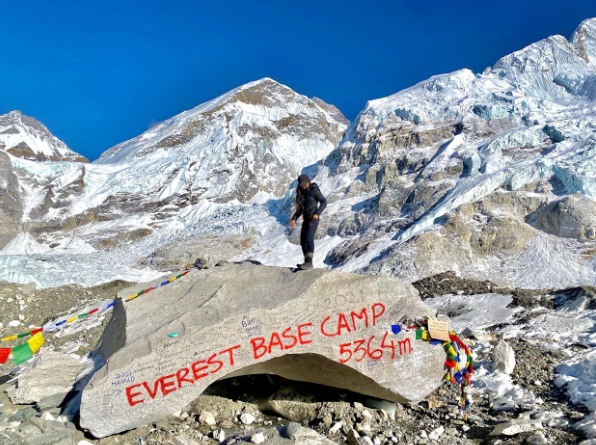The Everest Base Camp Trek stands as one of the world’s most iconic adventure journeys, drawing thousands of trekkers annually to the foot of Earth’s highest mountain. This legendary trail through Nepal’s Khumbu region offers far more than just proximity to Mount Everest—it’s a transformative experience that combines breathtaking Himalayan scenery, rich Sherpa culture, challenging high-altitude trekking, and the profound sense of achievement that comes from reaching the base of the world’s most famous peak at 5,364 meters (17,598 feet).
The Call of Everest
Since Sir Edmund Hillary and Tenzing Norgay first summited Everest in 1953, the mountain has captivated the global imagination. While only experienced mountaineers can attempt the summit itself, the base camp trek makes the Everest experience accessible to anyone with reasonable fitness, determination, and proper preparation. Walking the same paths used by legendary mountaineers, passing through villages where climbing Sherpas were born and raised, and standing at the staging ground for summit attempts creates a powerful connection to mountaineering history.
The trek isn’t just about the destination. The journey takes you through Sagarmatha National Park, a UNESCO World Heritage Site, where you’ll traverse suspension bridges swaying over roaring glacial rivers, walk through ancient rhododendron and pine forests, and witness some of the most dramatic mountain scenery on the planet. The cultural immersion—experiencing Buddhist monasteries, spinning prayer wheels, and sharing tea houses with fellow trekkers from around the world—adds depth that transforms this from a simple hike into a life-changing adventure.
The Classic Route
The standard Everest Base Camp trek typically takes 12-14 days round trip, though variations exist depending on your pace, acclimatization needs, and whether you add side trips. The adventure begins with one of the world’s most thrilling flights—the 35-minute journey from Kathmandu to Lukla’s Tenzing-Hillary Airport. This tiny airstrip, perched on a mountain shelf at 2,860 meters with a runway that slopes upward and ends at a cliff, consistently ranks among the world’s most dangerous airports. The dramatic approach between towering peaks gets your adrenaline pumping before you’ve even started walking.
From Lukla, the trail descends to the Dudh Kosi River and begins the rhythmic pattern of ascents and descents that characterizes Himalayan trekking. The path winds through Phakding, crosses spectacular suspension bridges decorated with prayer flags, and climbs steeply to Namche Bazaar (3,440m), the prosperous Sherpa capital built in a natural amphitheater. This colorful market town, with its bakeries, gear shops, Irish pubs, and Saturday market, serves as the first major acclimatization stop.
The trek continues to Tengboche (3,867m), home to the region’s largest monastery, where monks perform ceremonies accompanied by ceremonial horns and drums, and where Everest, Lhotse, and Ama Dablam frame the horizon in stunning perfection. From here, the trail passes through Dingboche (4,410m) and Lobuche (4,940m), settlements that become progressively more basic as altitude increases and vegetation disappears entirely.
Gorak Shep and Base Camp
The final settlement before base camp is Gorak Shep (5,164m), a collection of lodges perched on sandy flatlands that once formed part of a glacial lake. From here, trekkers typically walk to Everest Base Camp in the afternoon, a 3-4 hour round trip across the Khumbu Glacier’s rocky moraine. The trail is neither technically difficult nor particularly steep, but the altitude makes every step laborious.
Everest Base Camp itself can be somewhat anticlimactic—during trekking season (outside of climbing season), it’s simply a rocky, desolate area marked by cairns and prayer flags. During climbing season (April-May), however, it transforms into a bustling tent city filled with expedition teams, complete with mess tents, communications equipment, and the palpable tension and excitement of summit preparations. Even without the climbing circus, standing at base camp with the Khumbu Icefall tumbling down from the Western Cwm, knowing that climbers pass through this very spot on their way to the summit, creates a powerful emotional experience.
Kala Patthar: The Ultimate Viewpoint
While reaching base camp is the trek’s nominal goal, most trekkers consider the pre-dawn ascent of Kala Patthar (5,545m) to be the trek’s true highlight. This rocky outcrop provides the closest accessible view of Everest’s summit available without technical climbing equipment. The 2-3 hour climb from Gorak Shep usually begins around 4:30 AM, with headlamps illuminating the switchbacking trail in the bitter cold.
Reaching the summit as dawn breaks over the Himalayas ranks among trekking’s most magical moments. Everest’s summit pyramid, bathed in golden light, dominates the skyline, while Nuptse, Lhotse, Pumori, and countless other peaks create a 360-degree panorama of Himalayan majesty. The altitude—roughly half the oxygen available at sea level—makes every breath precious and every photograph a hard-won trophy. Many trekkers report that this moment, more than reaching base camp itself, justifies every challenging step of the journey.
The Challenge of Altitude
The Everest Base Camp trek’s greatest challenge isn’t technical difficulty or physical exertion—it’s altitude. At 5,364 meters, base camp sits well into the “extreme altitude” zone where the human body cannot fully acclimatize and begins slowly deteriorating. Acute Mountain Sickness (AMS) affects roughly 75% of trekkers to some degree, with symptoms ranging from mild headaches and fatigue to life-threatening conditions like High Altitude Pulmonary Edema (HAPE) and High Altitude Cerebral Edema (HACE).
Proper acclimatization is non-negotiable. This means ascending slowly, following the mountaineering adage “climb high, sleep low,” and building rest days into your itinerary. Most sensible itineraries include acclimatization days in Namche Bazaar and Dingboche, where you take day hikes to higher elevations before returning to sleep at lower altitudes. Staying hydrated, avoiding alcohol, recognizing symptoms early, and being willing to descend if conditions worsen can mean the difference between a successful trek and a medical emergency.
Experienced guides monitor trekkers carefully and carry oxygen supplies, but personal honesty about symptoms is crucial. Altitude sickness doesn’t discriminate—young, fit athletes can suffer while older trekkers sail through. The key is listening to your body and never pushing through serious symptoms just to reach a goal.
Tea House Trekking Experience
One of the EBC trek’s great advantages is the well-developed tea house infrastructure. Unlike expeditions requiring camping equipment and porters to carry everything, EBC trekkers can walk with just a daypack while staying in family-run lodges each night. These tea houses offer basic but adequate accommodation—simple rooms with twin beds and blankets, communal dining areas warmed by yak-dung stoves, and meals ranging from traditional dal bhat to pizza and pasta.
The tea house experience facilitates cultural exchange. Evening meals become social events where trekkers from dozens of countries share stories, play cards, and bond over shared challenges. The Sherpa families who run these lodges provide insights into local life, Buddhism, and the realities of living in one of Earth’s most extreme environments.
Best Seasons for Trekking
The optimal times for the Everest Base Camp Trek are pre-monsoon spring (March-May) and post-monsoon autumn (September-November). Autumn offers the most reliable weather, clearest skies, and stable conditions, making it the peak season. Temperatures are cold but manageable, and mountain views are typically spectacular. Spring provides warmer temperatures at lower elevations, rhododendron blooms adding color to the forests, and the excitement of sharing trails with climbing expeditions heading to base camp.
Winter trekking (December-February) is possible but demanding, with sub-zero temperatures, shorter days, and potential snow blocking high passes. Many lodges at higher elevations close for winter. Summer monsoon (June-August) brings heavy rainfall, leeches at lower elevations, obscured views, and dangerous conditions, making it the least desirable season.
Physical Preparation and Requirements
While the EBC trek requires no technical climbing skills, it demands good physical fitness and mental resilience. You’ll trek 5-7 hours daily, often gaining and losing significant elevation, at altitudes that leave you constantly short of breath. Proper preparation should include cardiovascular training (hiking, running, cycling), leg strengthening exercises, and ideally, practice hikes with a daypack.
Equally important is mental preparation. Days of challenging trekking, cold nights, basic facilities, and altitude’s cumulative effects test patience and determination. Flexibility, a positive attitude, and realistic expectations about comfort levels help immensely.
Conclusion
The Everest Base Camp Trek represents adventure travel at its most accessible yet profound. It challenges you physically while rewarding you with scenery that exceeds imagination, connects you with ancient cultures while building friendships with fellow travelers, and tests your limits while building confidence that extends far beyond the mountains. Standing at the base of the world’s highest peak, surrounded by the drama of the Himalayas, you join a select group who’ve made this journey and returned transformed. For anyone seeking adventure, natural beauty, and personal growth, the trek to Everest Base Camp remains an unparalleled bucket-list experience that lives up to every bit of its legendary reputation.

